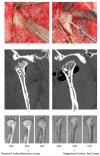Clinical Evaluation of Magnesium Alloy Osteosynthesis in the Mandibular Head
- PMID: 35160655
- PMCID: PMC8836973
- DOI: 10.3390/ma15030711
Clinical Evaluation of Magnesium Alloy Osteosynthesis in the Mandibular Head
Abstract
Titanium alloys are used in skeletal surgery. However, once bone union is complete, such fixation material becomes unnecessary or even harmful. Resorbable magnesium materials have been available for several years (WE43 alloy). The aim of this study was to clinically compare magnesium versus titanium open reduction and rigid fixations in mandible condylar heads. Ten patients were treated for fractures of the mandibular head with magnesium headless compression screws (2.3 mm in diameter), and 11 patients were included as a reference group with titanium screws (1.8 mm in diameter) with similar construction. The fixation characteristics (delay, time, and number of screws), distant anatomical results (mandibular ramus height loss, monthly loss rate, and relative loss of reconstructed ramus height), basic functional data (mandibular movements, facial nerve function, and cutaneous perception) and the influence of the effects of the injury (fracture type, fragmentation, occlusion, additional fractures, and associated diseases) on the outcome were evaluated. The long-term results of treatment were evaluated after 18 months. Treatment results similar to those of traditional titanium fixation were found with magnesium screws. Conclusions: Resorbable metal screws can be a favored option for osteosynthesis because surgical reentry can be avoided. These materials provide proper and stable treatment results.
Keywords: condylar head fracture; fixing material; fracture treatment; magnesium; mandible condyle; mandible fracture; mandible head; open rigid internal fixation; osteosynthesis; surgical treatment.
Conflict of interest statement
The authors declare no conflict of interest.
Figures









Similar articles
-
The Osteosynthesis of the Mandibular Head, Does the Way the Screws Are Positioned Matter?J Clin Med. 2022 Apr 5;11(7):2031. doi: 10.3390/jcm11072031. J Clin Med. 2022. PMID: 35407637 Free PMC article.
-
Bone Union Quality after Fracture Fixation of Mandibular Head with Compression Magnesium Screws.Materials (Basel). 2022 Mar 17;15(6):2230. doi: 10.3390/ma15062230. Materials (Basel). 2022. PMID: 35329682 Free PMC article.
-
Two versus three magnesium screws for osteosynthesis of mandibular condylar head fractures: a finite element analysis.Clin Oral Investig. 2024 Sep 27;28(10):553. doi: 10.1007/s00784-024-05927-5. Clin Oral Investig. 2024. PMID: 39327352 Free PMC article.
-
Volumetric Evaluated Bone Resorption After Open Reduction and Internal Fixation of Condylar Head Fractures of the Mandible.J Oral Maxillofac Surg. 2021 Sep;79(9):1902-1913. doi: 10.1016/j.joms.2021.04.018. Epub 2021 Apr 23. J Oral Maxillofac Surg. 2021. PMID: 34062130 Review.
-
The Use of Titanium 3D Mini-Plates in the Surgical Treatment of Fractures of the Mandibular Condyle: A Systematic Review and Meta-Analysis of Clinical Trials.J Clin Med. 2021 Aug 16;10(16):3604. doi: 10.3390/jcm10163604. J Clin Med. 2021. PMID: 34441900 Free PMC article. Review.
Cited by
-
The Osteosynthesis of the Mandibular Head, Does the Way the Screws Are Positioned Matter?J Clin Med. 2022 Apr 5;11(7):2031. doi: 10.3390/jcm11072031. J Clin Med. 2022. PMID: 35407637 Free PMC article.
-
Current Frequency of Mandibular Condylar Process Fractures.J Clin Med. 2023 Feb 9;12(4):1394. doi: 10.3390/jcm12041394. J Clin Med. 2023. PMID: 36835931 Free PMC article.
-
Titanium vs PEO Surface-Modified Magnesium Plate Fixation in a Mandible Bone Healing Model in Sheep.ACS Biomater Sci Eng. 2024 Aug 12;10(8):4901-4915. doi: 10.1021/acsbiomaterials.4c00602. Epub 2024 Jul 29. ACS Biomater Sci Eng. 2024. PMID: 39072479 Free PMC article.
-
Personalized Temporomandibular Joint Total Alloplastic Replacement as a Solution to Help Patients with Non-Osteosynthesizable Comminuted Mandibular Head Fractures.J Clin Med. 2024 Sep 5;13(17):5257. doi: 10.3390/jcm13175257. J Clin Med. 2024. PMID: 39274470 Free PMC article.
-
Titanium or Biodegradable Osteosynthesis in Maxillofacial Surgery? In Vitro and In Vivo Performances.Polymers (Basel). 2022 Jul 7;14(14):2782. doi: 10.3390/polym14142782. Polymers (Basel). 2022. PMID: 35890557 Free PMC article. Review.
References
-
- Dowgierd K., Pokrowiecki R., Borowiec M., Kozakiewicz M., Smyczek D., Krakowczyk Ł. A Protocol for the Use of a Combined Microvascular Free Flap with Custom-Made 3D-Printed Total Temporomandibular Joint (TMJ) Prosthesis for Mandible Reconstruction in Children. Appl. Sci. 2021;11:2176. doi: 10.3390/app11052176. - DOI
Grants and funding
LinkOut - more resources
Full Text Sources

